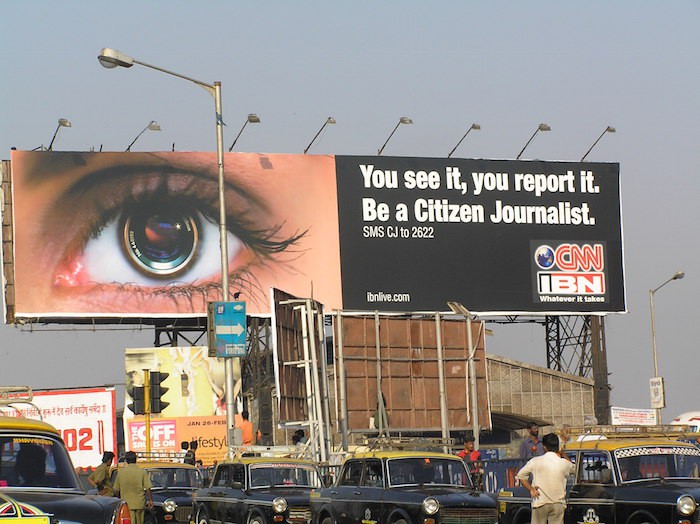
As mainstream media increasingly relies on citizens contributing content, it raises questions of ethics and responsibility, risks and safety. Should media houses be morally bound to protect interests of those whose work they thrive upon?
The dreadful events of the 7/7 London bombings marked a pivotal moment in the history of journalism. Much of what we know of the event is through citizens’ eyewitness accounts and mobile phone images. Since, citizens have become an integral part of telling any major news story across the world, as the recent tragic events in Sousse show.Bill Keller, the former New York Times editor, once coined the sardonic phrase “the Replacements” for freelancers who went to war zones, untrained and unsupported. Perhaps this term can be applied to citizen journalists as well.
Armed with a smartphone, “accidental journalists” today are often on the scene of stories before any professional journalist can get there. In countries such as Syria, citizens are reporting stories that are often too risky for staffers, and even freelancers. The high-profile murders of American journalists James Foley and Steven Sotloff, and more recently Japanese journalist Kenji Goto, have once again raised the issue of risks of reporting from a conflict zone.
The question then arises: What responsibility does mainstream media have towards those they do not employ and usually do not pay, but whose content they use?
Sam Dubberley, cofounder of Eyewitness Media Hub, a not-for-profit organization founded in 2014, says news outlets have a clear responsibility towards the people whose content they use:
Using eyewitness media is not just about finding content on Twitter and quickly publishing it. News organizations need to remember they have a duty of care towards those whose content they use. How to use eyewitness media should be part of every journalist’s toolkit.
Six months into 2015, eight citizen journalists have been killed and 185 imprisoned according to Reporters Without Borders. These figures are significantly lower than 2012 — which was dubbed the most deadly year — but the numbers remain high.
There are several risks involved. Observers may unwittingly put themselves in physical danger in trying to get the perfect shot of a tornado or earthquake. Activists in a war zone without the flak jacket, helmet, or hefty insurance that most staffers have may be putting themselves in harm’s way.
There are political problems too: Covering a riot, a demonstration or coup may put citizen journalists in conflict with authorities. For instance, last year, Antonio French, an alderman from St. Louis who tweeted and recorded videos of demonstrations and police actions in Ferguson, found himself arrested.
Some photos from last night in #Ferguson that I didn't get to post before I was arrested. pic.twitter.com/tww28XeS0m
— Antonio French (@AntonioFrench) August 14, 2014
Professor Robert Picard of the Reuters Institute for the Study of Journalism says media organizations have a duty of care towards those whose content they rely on.
All media are increasingly relying on photos, video, and information provided by citizen journalists. They have a moral obligation to speak out when authorities inappropriately constrain, detain, or attack them.
Responsible news organizations put a warning on their sites asking citizen journalists not to endanger themselves in any way to get a story. The BBC, for example, has it specifically written into its guidance note on requesting user-generated content.
There are issues around ethics and media literacy: Citizen journalists may not be aware of questions of privacy or what legal restrictions there may be. As far back as 2009, the American academic Susan D. Moeller suggested in a report that government agencies, international organizations and private foundations should fund the teaching of best practice to citizen journalists.
“There is a clear difference between the activist uploading content with a cause in mind, and the accidental witness who stumbles across a newsworthy event and captures it on camera,” says Dubberley.
He adds in the first case, there is a journalistic duty to explain to the audience why this content is being published and with what purpose. In the latter, there is a duty to ensure that the accidental witness is treated fairly and that their wishes are respected. Understanding this difference is paramount, Dubberly points out.
David Wastell, foreign editor of The Independent, says his newspaper tends to avoid using citizens as journalists:
Our reporters may talk to them and put together a report distilling what they said. I think we use them more as a conventional source.
Media organizations must consider not just the physical dangers but the psychological toll all of this entails. As Dubberley puts it, the media has a duty of care towards users whose content it uses, especially in case of traumatic events. At the same time, staff journalists who watch potentially distressing user-generated content day after day may need psychological support too.
![]() Glenda Cooper is a lecturer in journalism at City University London.
Glenda Cooper is a lecturer in journalism at City University London.
